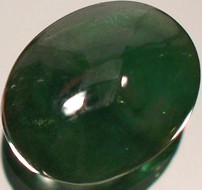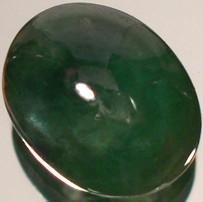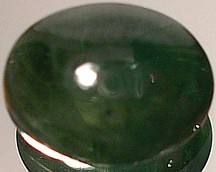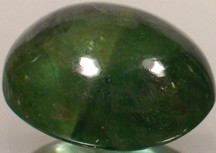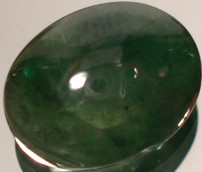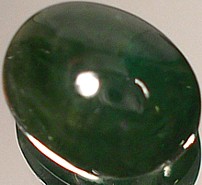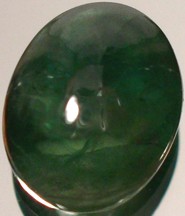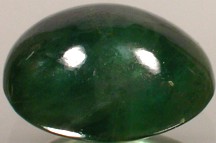|
For Customers outside of USA 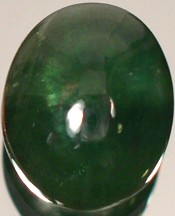
Very Large Antique 18th Century Handcrafted Genuine Natural Russian Three and One-Third Carat Vibrant Regal Green Sapphire. ORIGIN: The Ural Mountains, Russia. 18th Century. SIZE: Length: 9mm. Width: 7mm. Depth (Thickness): 5mm. All measurements approximate. WEIGHT: 3.32 carats. NOTES: Upon request we can set your gemstone as a ring, pendant, or into earrings.
DETAIL: A handsome, vibrantly colored green sapphire precious gemstone from the Ural Mountains of Russia. Hand crafted by an 18th century Russian artisan, part of an heritage renown for the production of the elaborate gemstones and jewelry of the Czars of Medieval, Renaissance, and Victorian Russia. Originally used in indigenous jewelry, this is a very beautiful precious gemstone, with vibrant green color of good intensity. Though in the 18th century this would have been considered a very nice quality gemstone (and priced accordingly), by today's standards it is rather average. It is by and large near eye clean, though certainly not flawless, and of higher value transparent character as opposed to lower value translucent and opaque sapphires. Though merely average by today's standards, it is nonetheless exceptional given its history. Of course most sapphire gemstones are anywhere from lightly to heavily included.
Though this specimen is much more transparent than translucent, complete transparency is slightly impaired by some very fine colorless crystalline material. Though this fine colorless crystalline material is not noticeable to the unaided eye - and to casual glance simply appears to be a brightly colored green sapphire of good luster, nice sparkle, and even color - to close scrutiny, as is seen in these photo enlargements, there are tiny little colorless crystalline blemishes. There is also a little bit of color zoning, which means that if you look very carefully and closely you will see areas of different shades of color within the gemstone. However both the fine colorless crystalline material as well as the color zoning are quite common with sapphire (and rubies) of this large size, and in no way detracts from its beauty. Of course most completely transparent, flawless sapphires you see offered today at retail are either synthetic (read the fine print carefully) or priced at $10,000 a carat. While this particular specimen might not be anywhere near flawless, to casual scrutiny it is at "near eye clean". To the non-critical view it is simply a vividly hued green sapphire possessing very handsome luster and remarkable history.
Green sapphires are precious gemstones, and in high demand, and thus can be quite costly, however the Southern Ural Mountains of Russia have been producing good quality, natural sapphires for centuries. And again, though by today's standards this specimen is only of medium quality, by 19th century standards it would have been quite desirable and would have commanded a high price. The trained eye will easily discern the tell-tale indicators that the gemstone was hand cut and hand polished. The coarseness of the 18th century finish is considered appealing to most gemstone collectors, and is not considered a detriment. In fact these characteristics of a hand crafted gemstone are considered part and parcel of the magic of such an antique gemstone. Unlike today's computer controlled machine processes, the cut and finish of gemstones such as these is the legacy of an artisan who lived two centuries ago. Such antique hand-faceted gemstones possess much greater character and appeal than today's mass-produced machine-tumbled gemstones. The gemstone possesses great lustre, and the blemishes it possesses are not obvious to casual scrutiny.
Consider that these characteristics are not only expected of hand-finished gemstones, but also that two centuries ago the mining techniques prevalent did not allow the ultra deep mining operations which are so common today. Two centuries ago mankind was more or less limited to surface deposits or near surface deposits of semi-precious gemstones. Higher quality gemstones which today are routinely mined from beneath hundreds of meters, even kilometers beneath the earth's surface, were simply inaccessible. This is why antique gemstone must be appreciated as antiques first, gemstones second. The relatively superlative quality of contemporary gemstones mined from deep beneath the earth's surface were simply not accessible two centuries ago, or at least, only rarely so. But for most, the unique nature and character of these antique gemstones more than makes up for included imperfections which by and large are only visible under magnification.
HISTORY: Sapphires have been since ancient times one of the most highly valued of all gemstones, and references to the gemstone date back to about 800 B.C. The name "sapphire" comes from the Latin "sapphirus" and the Greek "sappheiros", which translates to "blue" in both languages. The name sapphire is also a derivative of the ancient Hebrew and Persian word for "blue" as well. To the ancient Romans however, the word "sapphirus" actually referred to lapis lazuli, another blue gemstone. What the Romans called blue sapphire translates to "hyacinth"; the green sapphire was "emerald", and the purple sapphire was "amethyst". In the ancient Mediterranean world, priests and sorcerers honored the sapphire above all other gems. They believed that the sapphire enabled them to interpret oracles and foretell the future.
The ancient Persians believed that the earth rested on an enormous sapphire, and the sky reflected its beautiful color. They referred to the sapphire as "the gem of the heavens". As the centuries passed, European royalty came to favor sapphire believing the stone would provide protection from harm. Throughout Medieval Europe, the sapphire was thought to give the wearer strengthened vision, including visions of the future. Sapphire was regarded as an antidote to black magic and effects of evil spirits. It was held to be a symbol of truth and constancy. Sapphires are a member of the corundum family, and close relative to the ruby. In fact, a ruby is simply a red sapphire. The sapphire is considered one of the most valuable of precious stones. The principal sources of sapphire in modern history are Russia, Siam, Ceylon, Burma, Africa, and Australia.
SHIPPING OPTIONS: All purchases are backed by an unlimited guarantee of satisfaction and authenticity. If for any reason you are not entirely satisfied with your purchase, you may return it for a complete and immediate refund of your entire purchase price. Most of these antique gemstones were originally part of two collections, one originating in India principally composed of gemstones originally mined in India, Burma, Ceylon, and Siam, and then hand faceted in India. The addition of a second accumulation of antique gemstones originally mined in the Urals in the mid to late 19th century (including alexandrite) completed the collection. These gemstones as well were hand finished. The Urals have been one of the world's major sources of precious and semi-precious gemstones for many centuries. As well, additional specimens are occasionally acquired from other institutions and dealers in Eastern Europe and Asia. These antique gemstones are now in the United States and are available for immediate delivery. We ship inventory from the USA order fulfillment center near Seattle, Washington. Your purchase will ordinarily be shipping within 48 hours of payment. A certificate of authenticity is available upon request. We prefer your personal check or money order over any other form of payment - and we will ship immediately upon receipt of your check (no "holds"). We will accept PayPal payments. Please see our "ADDITIONAL TERMS OF SALE".
|
|---|
